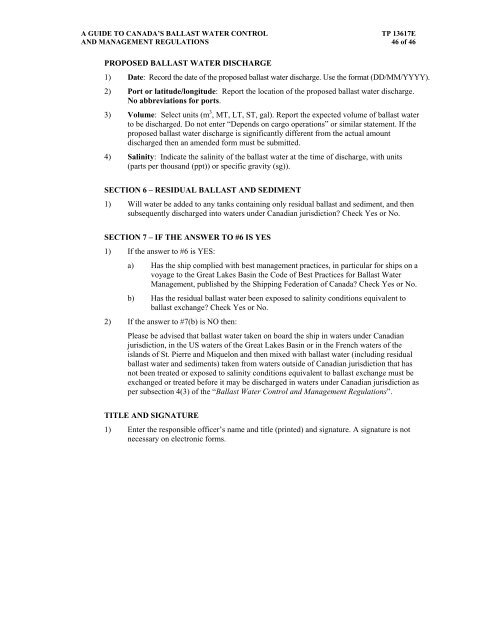A guide to canada's ballast water control and - Transports Canada
A guide to canada's ballast water control and - Transports Canada
A guide to canada's ballast water control and - Transports Canada
Create successful ePaper yourself
Turn your PDF publications into a flip-book with our unique Google optimized e-Paper software.
A GUIDE TO CANADA’S BALLAST WATER CONTROL TP 13617E<br />
AND MANAGEMENT REGULATIONS 46 of 46<br />
PROPOSED BALLAST WATER DISCHARGE<br />
1) Date: Record the date of the proposed <strong>ballast</strong> <strong>water</strong> discharge. Use the format (DD/MM/YYYY).<br />
2) Port or latitude/longitude: Report the location of the proposed <strong>ballast</strong> <strong>water</strong> discharge.<br />
No abbreviations for ports.<br />
3) Volume: Select units (m 3 , MT, LT, ST, gal). Report the expected volume of <strong>ballast</strong> <strong>water</strong><br />
<strong>to</strong> be discharged. Do not enter “Depends on cargo operations” or similar statement. If the<br />
proposed <strong>ballast</strong> <strong>water</strong> discharge is significantly different from the actual amount<br />
discharged then an amended form must be submitted.<br />
4) Salinity: Indicate the salinity of the <strong>ballast</strong> <strong>water</strong> at the time of discharge, with units<br />
(parts per thous<strong>and</strong> (ppt)) or specific gravity (sg)).<br />
SECTION 6 – RESIDUAL BALLAST AND SEDIMENT<br />
1) Will <strong>water</strong> be added <strong>to</strong> any tanks containing only residual <strong>ballast</strong> <strong>and</strong> sediment, <strong>and</strong> then<br />
subsequently discharged in<strong>to</strong> <strong>water</strong>s under Canadian jurisdiction? Check Yes or No.<br />
SECTION 7 – IF THE ANSWER TO #6 IS YES<br />
1) If the answer <strong>to</strong> #6 is YES:<br />
a) Has the ship complied with best management practices, in particular for ships on a<br />
voyage <strong>to</strong> the Great Lakes Basin the Code of Best Practices for Ballast Water<br />
Management, published by the Shipping Federation of <strong>Canada</strong>? Check Yes or No.<br />
b) Has the residual <strong>ballast</strong> <strong>water</strong> been exposed <strong>to</strong> salinity conditions equivalent <strong>to</strong><br />
<strong>ballast</strong> exchange? Check Yes or No.<br />
2) If the answer <strong>to</strong> #7(b) is NO then:<br />
Please be advised that <strong>ballast</strong> <strong>water</strong> taken on board the ship in <strong>water</strong>s under Canadian<br />
jurisdiction, in the US <strong>water</strong>s of the Great Lakes Basin or in the French <strong>water</strong>s of the<br />
isl<strong>and</strong>s of St. Pierre <strong>and</strong> Miquelon <strong>and</strong> then mixed with <strong>ballast</strong> <strong>water</strong> (including residual<br />
<strong>ballast</strong> <strong>water</strong> <strong>and</strong> sediments) taken from <strong>water</strong>s outside of Canadian jurisdiction that has<br />
not been treated or exposed <strong>to</strong> salinity conditions equivalent <strong>to</strong> <strong>ballast</strong> exchange must be<br />
exchanged or treated before it may be discharged in <strong>water</strong>s under Canadian jurisdiction as<br />
per subsection 4(3) of the “Ballast Water Control <strong>and</strong> Management Regulations”.<br />
TITLE AND SIGNATURE<br />
1) Enter the responsible officer’s name <strong>and</strong> title (printed) <strong>and</strong> signature. A signature is not<br />
necessary on electronic forms.

















